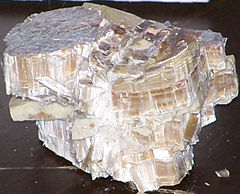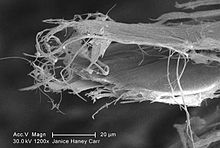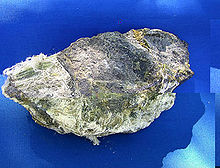- Chrysotile
-
Chrysotile 
Chrysotile serpentine from the Salt River area, ArizonaGeneral Category Silicate mineral
(serpentine group)Chemical formula Mg3(Si2O5)(OH)4
(ideal)Identification Molar mass 277.11 g/mol
(ideal)Color grey to green Crystal habit acicular Crystal system monoclinic or orthorhombic Fracture fibrous Mohs scale hardness 2½–3 Luster silky Streak white Diaphaneity translucent Density 2.53 g/ml Refractive index 1.545–1.569; 1.553–1.571 Birefringence 0.008 (max) Dispersion relatively weak Fusibility dehydrates at 550–750 °C Solubility insoluble in water
fibres degrade in dilute acidChrysotile or white asbestos is the most commonly encountered form of asbestos,[1] accounting for approximately 95% of the asbestos in place in the United States[2] and a similar proportion in other countries.[3] It is a soft, fibrous silicate mineral in the serpentine group of phyllosilicates; as such, it is distinct from other asbestiform minerals in the amphibole group. Its idealized chemical formula is Mg3(Si2O5)(OH)4.[1]
Contents
Polytypes
Three polytypes of chrysotile are known.[4] These are very difficult to distinguish in hand specimens, and polarized light microscopy[2] must normally be used. Some older publications refer to chrysotile as a group of minerals—the three polytypes listed below, and sometimes pecoraite as well—but the 2006 recommendations of the International Mineralogical Association prefer to treat it as a single mineral with a certain variation in its naturally-occurring forms.[5]
Name Crystal system Type locality mindat.org reference Unit cell parameters Crystal structure reference Clinochrysotile monoclinic Złoty Stok*, Lower Silesia, Poland a = 5.3 Å; b = 9.19 Å; c = 14.63 Å; β = 93° [6] Orthochrysotile orthorhombic Kadapa* district, Andhra Pradesh, India a = 5.34 Å; b = 9.24 Å; c = 14.2 Å [7] Parachrysotile orthorhombic uncertain a = 5.3 Å; b = 9.24 Å; c = 14.71 Å [8] Source: mindat.org.
*Złoty Stok and Kadapa have formerly been known as Reichenstein and Cuddapah respectively, and these names may appear in some publications.Clinochrysotile is the commonest of the three forms, found notably at Asbestos, Quebec, Canada. Its two measurable refractive indices tend to be lower than those of the other two forms.[9] The orthorhombic paratypes may be distinguished by the fact that, for orthochrysotile, the higher of the two observable refractive indices is measured parallel to the long axis of the fibres (as for clinochrysotile); whereas for parachrysotile the higher refractive index is measured perpendicular to the long axis of the fibres.
Physical properties
Bulk chrysotile, whose hardness is about the same as that of a human fingernail, is easily crumbled to fibres that are, in fact, bundles of fibrils. Naturally-occurring fibre bundles range in length from several millimetres to more than ten centimetres,[1] although industrially-processed chrysotile usually has shorter fibre bundles. The diameter of the fibre bundles is 0.1–1 µm, and the individual fibrils are even finer, 0.02–0.03 µm, each fibre bundle containing tens or hundreds of fibrils.[3] Chrysotile fibres have considerable tensile strength, and may be spun into thread and woven into cloth. They are also resistant to heat and are excellent thermal, electrical and acoustic insulators.[1][3]
Chemical properties
The idealized chemical formula of chrysotile is Mg3(Si2O5)(OH)4, although some of the magnesium ions may be replaced by iron or other cations. Substitution of the hydroxide ions for fluoride, oxide or chloride is also known, but rarer.[1] A related, but much rarer, mineral is pecoraite, in which all the magnesium cations of chrysotile are substituted by nickel cations.
Chrysotile is resistant to even strong bases (asbestos is thus stable in high pH pore water of Portland cement), but the fibres are attacked by acids: the magnesium ions are selectively dissolved, leaving a silica skeleton. It is thermally stable up to around 550 °C, at which temperature it starts to dehydrate. Dehydration is complete at about 750 °C, with the final products being forsterite (magnesium silicate), silica and water.[3]
The global mass balance reaction of the chrysotile dehydration can be written as follows:
- Chrysotile (serpentine) → Forsterite + silica + water
- 2Mg3Si2O5(OH)4 → 3Mg2SiO4 + SiO2 + 4H2O
The chrysotile (serpentine) dehydration reaction corresponds in fact to the reverse of the forsterite (Mg-olivine) hydrolysis in the presence of dissolved silica (silicic acid).
Safety concerns
Chrysotile has been included with other forms of asbestos, in being considered to be a human carcinogen by the International Agency for Research on Cancer (IARC)[10] and by the U.S. Department of Health and Human Services.[1] which states "Asbestos exposure is associated with parenchymal asbestosis, asbestos-related pleural abnormalities, peritoneal mesothelioma, and lung cancer, and it may be associated with cancer at some extra-thoracic sites".[11] In other scientific publications, epidemiologists have published peer reviewed scientific papers establishing that chrysotile is the main cause of pleural mesothelioma. [12][13][14]
Chrysotile has been recommended for inclusion in the Rotterdam Convention on Prior Informed Consent,[15] an international treaty that restricts the global trade in hazardous materials. If listed, exports of chrysotile would only be permitted to countries that explicitly consent to imports. Canada, a major producer of the mineral, has been harshly criticized by the Canadian Medical Association[16][17] for its opposition to including chrysotile in the Convention.[18]
See also
References
- ^ a b c d e f U.S. Department of Health and Human Services (2005). "Asbestos." Report on Carcinogens, Eleventh Edition.
- ^ a b Occupational Safety and Health Administration, U.S. Department of Labor (2007). 29 C.F.R. 1910.1001. Appendix J.
- ^ a b c d Institut national de recherche sur la sécurité (1997). "Amiante." Fiches toxicologiques. n° 167. (in French)
- ^ Wicks, F. J.; Whittaker, E. J. W. (1975). "A reappraisal of the structures of the serpentine minerals". The Canadian Mineralogist 13 (3): 227–243. http://canmin.geoscienceworld.org/cgi/content/abstract/13/3/227.
- ^ Burke, Ernst A. J. (2006). "A Mass Discreditation of GQN Minerals". The Canadian Mineralogist 44 (6): 1557–60. doi:10.2113/gscanmin.44.6.1557. http://pubsites.uws.edu.au/ima-cnmnc/GQNminerals.pdf.
- ^ Whittaker, E. J. W. (1956). "The structure of chrysotile. II. Clino-chrysotile". Acta Crystallographica 9 (11): 855–62. doi:10.1107/S0365110X5600245X.
- ^ Whittaker, E. J. W. (1956). "The structure of chrysotile. III. Ortho-chrysotile". Acta Crystallographica 9 (11): 862–64. doi:10.1107/S0365110X56002461.
- ^ Whittaker, E. J. W. (1956). "The structure of chrysotile. IV. Para-chrysotile". Acta Crystallographica 9 (11): 865–67. doi:10.1107/S0365110X56002473.
- ^ In principle, all polytypes of chrysotile should have three independent refractive indices: in practice, two of the three are so close as to be indistinguishable by experimental measurement.
- ^ International Agency for Research on Cancer (1998). "Asbestos." However, the study states " In some of these case reports and in other studies, asbestos fibres have been identified in the lung. Amphibole fibres have usually predominated, but in a few cases mainly or only chrysotile fibres were found." IARC Monographs on Evaluating the Carcinogenic Risks to Humans. Supplement 7.
- ^ Agency for Toxic Substances and Disease Registry (ATDSR), U.S. Department of Health and Human Services (2007). "Asbestos Toxicity." Case Studies in Environmental Medicine.
- ^ [1] See e.g., Smith, Allen "Chrysotile is the main cause of pleural mesothelioma", Amer.J.Indus.Med., Vol. 32, pp. 252 to 266 (1996)
- ^ [2] Tossavainen A, "Asbestos, asbestosis, and cancer: the Helsinki criteria for diagnosis and attribution" Scand J Work Environ Health 1997;23(4):311-316 - stating that all types of malignant mesothelioma can be induced by asbestos, with the amphiboles showing greater carcinogenic potency than chrysotile
- ^ [3] Lemen RA 2010. Chrysotile Asbestos and Mesothelioma. Environ Health Perspect 118:a282-a282
- ^ Rotterdam Convention: Chrysotile
- ^ Attaran, Amir; Boyd, David R.; Stanbrook, Matthew B. (October 2008). "Asbestos mortality: a Canadian export". CMAJ 179 (9): 871–2. doi:10.1503/cmaj.081500. PMC 2565724. PMID 18936444. http://www.pubmedcentral.nih.gov/articlerender.fcgi?tool=pmcentrez&artid=2565724.
- ^ Collier, Roger (December 2008). "Health advocates assail Canada's asbestos stance". CMAJ 179 (12): 1257. doi:10.1503/cmaj.081806. PMC 2585122. PMID 19047602. http://www.pubmedcentral.nih.gov/articlerender.fcgi?tool=pmcentrez&artid=2585122.
- ^ MITTELSTAEDT, MARTIN (September 10, 2008). "Canada still blocking action on asbestos". The Globe and Mail (Toronto). http://www.theglobeandmail.com/servlet/Page/document/v5/content/subscribe?user_URL=http://www.theglobeandmail.com%2Fservlet%2Fstory%2FLAC.20080910.ASBESTOS10%2FTPStory%2FNational&ord=87597914&brand=theglobeandmail&force_login=true. Retrieved 2008-10-01.
External links
- The Chrysotile Institute
- International Chemical Safety Card 0014
- Webmineral
- Mindat clinochrysotile
- Mindat orthochrysotile
- Mindat parachrysotile
- "Asbestos-containing Floor Tile and Mastic Abatement: Is there Enough Exposure to Cause Asbestos-related Disease?"
- Deer William Alexander, Howie Robert Andrew, Zussman Jack, An introduction to the rock-forming minerals, ISBN 0-582-30094-0, OCLC 183009096 pp. 344–352, 1992
- Ledoux, RL (ed), Short course in mineralogical techniques of asbestos determination, Mineralogical Association of Canada, pp. 35–73, 185, 1979.
- http://www.microlabgallery.com/ChrysotileFile.aspx Photomicrographs of parachrysotile and clinochrysotile
- Nolan, RP, Langer AM, Ross M, Wicks FJ, Martin RF (eds), "The health effects of chrysotile asbestos", The Canadian Mineralogist, Special Publication 5, 2001.
Serpentine group Clay mineral group Chlorite1 · Dickite · Halloysite · Illite · Ilmenite · Kaolinite · Montmorillonite · Nacrite · Nontronite · Palygorskite · Saponite · Sepiolite · Serpentine1 · TalcMica group Chlorite group 1. Serpentine and Chlorite are sometimes considered clay minerals Categories:- Serpentine group
- Magnesium minerals
- Asbestos
- IARC Group 1 carcinogens
Wikimedia Foundation. 2010.


